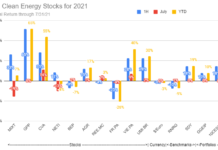Dana Blankenhorn
Some reporters are calling the latest PwC Renewables Report a sign of a “renewables frenzy,” in that the number of merger deals in the space climbed to 530 last year, from just 319 in 2009.
But is it?
The total value of all deals in the space, according to the same report, actually fell sharply, to $33.4 billion from $48.8 billion. Major indexes like the Wilderhill New Energy Index and the PowerShares Global Clean Energy ETF (PBD) both fell in value last year, even while the average stock was rising in value.
There are many reasons for doing a deal. Growth is one, scale is one, fear of failure another. And lumping co-generation, biomass, wind, solar, and hydro deals into one pot called “renewables” is a big mistake, in my view, because each of these sectors faces its own challenges and has its own outlook.
The market for wood pellets from Confluence Energy, just acquired by Viridis Energy (VRD.V) in Canada, is very different from the markets served by the coming Alterra Corp. (MGMXF.PK), a merger I covered early this month.
Similarly, the environment faced by a solar energy acquisition outfit like Principal Solar (KPCG.PK), which just went public through a pink sheets merger, is nothing like that faced by Next-Alternative, a maker of carbon-nanotube batteries, controllers, and a fuel emulsifier which just trumpeted an offer of $100 million (which it rejected).
Fact is, renewable energy is a whole collection of sectors, each with its own dynamic, each at a different stage of its market development. Wind turbines, for instance, are clearly understood, not highly subject to disruptive entrants (someone who can double the wind’s output), and so fairly mature. Solar energy is much less so. There are a whole related set of industries – materials and tools and sales channels – that is each unique unto itself.
The PwC report, and the way it was released (sent via email to clients with no press release posted on the company Web site as of this morning), seems designed to feed the hype. “Deals up 66%,” “confidence returns” and “strong year” are the words I’m reading in the headlines.
But is that the reality? Personally, I don’t see this as an M&A business right now. I see a lot of opportunity for financing, I see a lot of new investments in untried technology, I see a lot of contracts connecting projects to the grid, most of them based on some sort of guarantee.
What do you think? Does the industry really need a hot M&A pipeline to make money? Or do the investment bankers need us more than we need them?
Dana Blankenhorn first covered the energy industries in 1978 with the Houston Business Journal. He returned after a short 29 year hiatus because it’s the best business story of our time. In between he covered PCs, the Internet, e-commerce, open source, the Internet of Things and Moore’s Law. It’s the application of the last to harvesting the energy all around us he’s most excited about. He lives in Atlanta.








